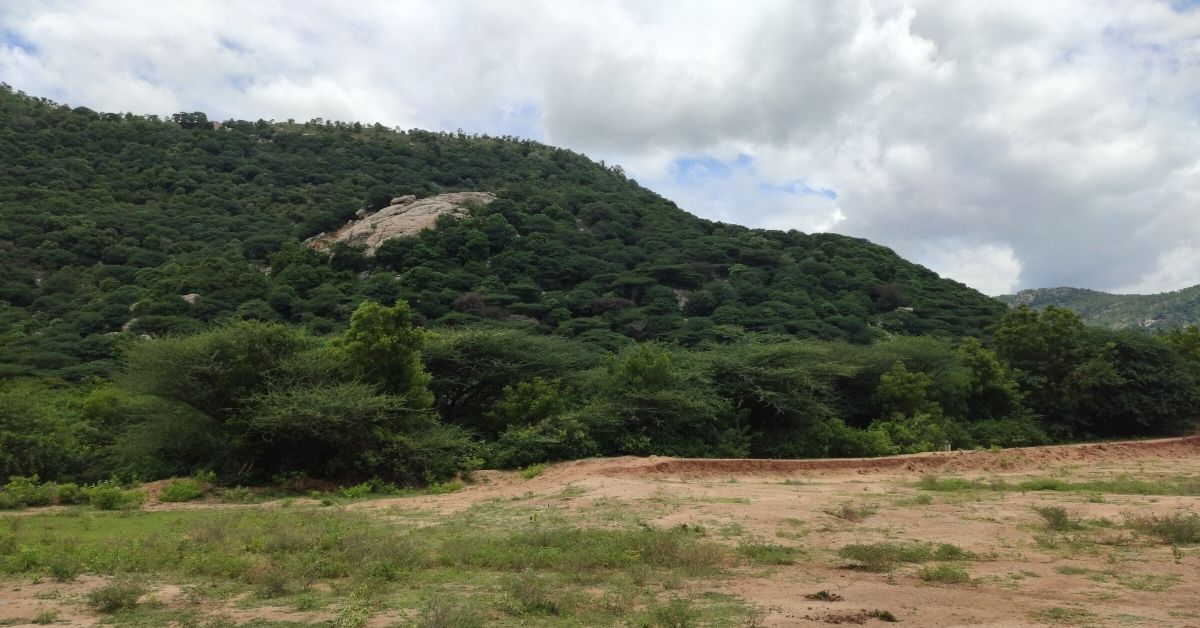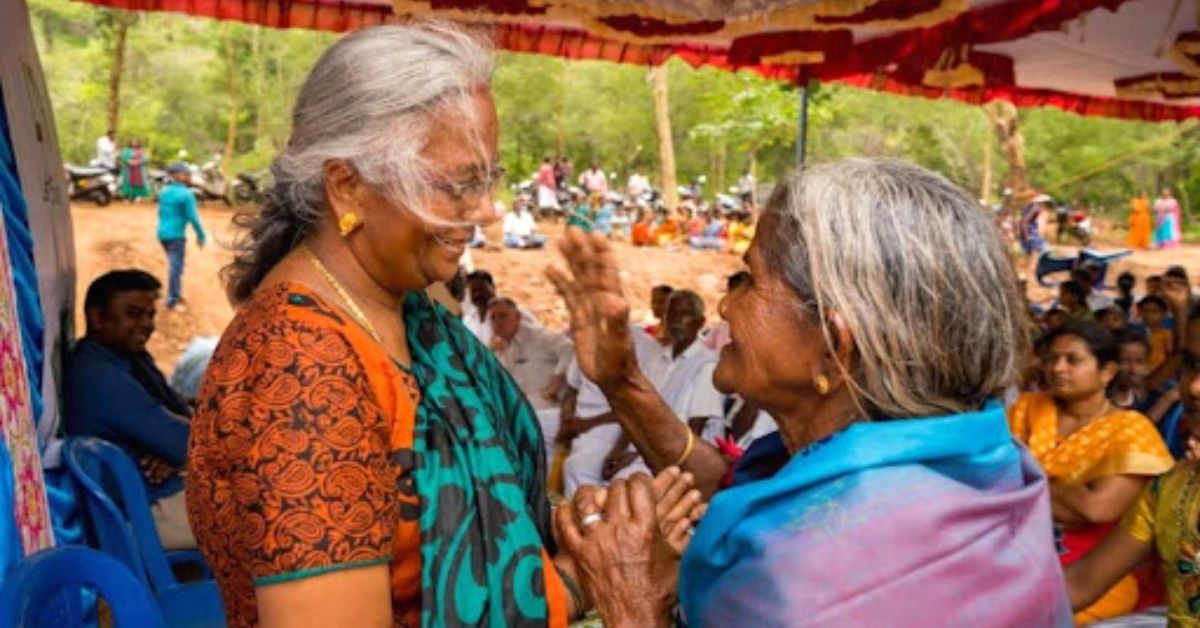After Decades Of Drought, One ‘Akka’ Helped This Village Restore 6 Cr Litres Of Water
Here’s the story of Malarvizhli Akka, a social worker in Tamil Nadu who helped residents of Chinnapallikuppam village end decades of water woes by reviving a 2-acre pond

Malarvizhli Akka died a sudden death due to multiple organ failure in 2019. But not a day goes by that villagers of Chinnapallikuppam and its surrounding hamlets don’t remember her work and legacy. The woman, who died well into her sixties, has left an eternal imprint on the residents of this hamlet.
“Our village was suffering from water scarcity, and farming was difficult. Farmers lived in distress and could hardly cultivate one crop a year. The locals were migrating to cities for labour work, took up tannery, or pursued other alternate jobs for a living. But we are forever grateful to Akka (elder sister) that our village is drought-free after 20 years and is charting a path of prosperity,” says Vijay Kumar, a village resident.
Malarvizhli, a resident of Chennai, devoted her life to various environmental and social causes, working closely with NGOs and social groups.
For a drought-free life

In 2016, she created a WhatsApp group named Pakirvu, which translates to ‘sharing’ in Tamil. The group was made up of experts and environment lovers who wanted to contribute to conserving the environment.
On one occasion, she learned about Chinnapallikuppam village from her friend Dayalan, who was a member of the group.
“Dayalan was a friend of Malarvizhli, and they worked closely together for over 20 years. Malarvizhli always considered villages as the economic backbone of the nation. She travelled far and remote settlements to create awareness and mobilise villagers promoting organic, sustainable farming and implementing other progressive methods,” says Senthil, a friend and part of Malarvizhli’s environment group.
Senthil says the village is known for its monoculture cropping and cultivating coconuts. “One can see stretches of coconut trees in the village. It is mainly due to water shortage and lack of a reliable source of income due to erratic rainfall patterns. On one occasion, Malarvizhli decided to visit the village to convince villagers to diversify the crops,” he adds.
Malarvizhli was well aware that monoculture cropping is unhealthy for the environment, and she tried to create awareness among the villagers. “Interactions with the locals revealed that the farmers faced severe water scarcity and lived at the mercy of monsoons,” he says.
She walked around the village to find a solution, and in the process, ended up standing by a hill just at the outskirts of the settlement. “She saw a large pit at the foothills and inquired about it. Malarvizhli learned it was a 2-acre percolation pond under the jurisdiction of the state forest department, and had been created by the Tamil Nadu government for locals in 1996,” he says.
He adds, “The dry water body was neglected to the extent that many villagers had even forgotten about the existence of the percolation pond.”
The villagers further told her that the pond served to meet their water requirements, but irregular rainfall and overexploitation of groundwater had left it dry. Groundwater levels had depleted up to 600 feet in the village. The surface rainwater run-off had caused erosion from the adjacent hill’s deposited soil. The pond was in poor condition and had become a fertile ground for invasive species, thereby reducing its water-storing capabilities.
But Malarvizhli immediately recognised the potential of the percolation pond and wanted to revive it. She approached SayTrees, an NGO that works towards environmental causes. “She knew about their pond restoration work in Thoppur, about 300 km away from our village, and approached them for help,” he says.
“A team from the NGO visited the village to inspect the pond. They agreed to revive it through multiple interventions. But the villagers were doubtful,” Senthil recalls.

Nithya, a preschool teacher from the village, says, “The villagers doubted if the pond would still function after years of neglect and fill with water. Malarvizhli said it would help recharge groundwater as the geographic structure indicated the water had seeped in the ground. Though reluctantly, about 170 villagers decided to support her.”
Kapil Sharma, the founder of the NGO, says, “A team of experts at the organisation conducted a hydrogeological assessment. The observations revealed that reviving the percolation pond could help increase water retention capacity and improve soil moisture levels. The interventions would enable groundwater recharge and, in turn, would help in irrigation and provide better fodder for cattle.”
The NGO and residents invested 60 days from August 2019 to revive the pond.
The villagers removed the invasive plant species, desilted the pond, and deepened it through an excavator to increase its water storing capacity. “A bund wall was also constructed up to 7 feet to allow maximum water to be stored in the pond. The locals received employment for participating in the project,” he says.
Additionally, the villagers dug a channel to divert water from the pond across the farms. “The water overflowing from the percolation pond during monsoons would make its way to the channels, ensuring that it does not go without being utilised. The villagers also constructed soak pits along the water channel to ensure the soil maintained certain moisture levels,” he adds.
Villagers also created barrages in the catchment area and cleaned the water run-off area on the hill to assist percolation in the ground. They managed and maintained the interventions until the structures stabilised.
Senthil says Malarvizhli coordinated with the government agencies and the forest department to seek necessary approvals. “It was a challenge for her, as the villagers did not know about legal requirements, and she alone had to move multiple offices for the permissions,” Senthil says.
In 2020, the village received significant rains, which helped fill the pond. “The water trickled down from the hill and the pond. The process continued for months which recharged the groundwater,” Senthil says.
Today, the pond remains filled with water throughout the year, with a water storage capacity of 6 crore litres. The pond slowly releases the water into the ground, which helps increase and maintain groundwater levels. All pen wells in the village have seen increased water levels.
A path to prosperity

“The moisture-retaining capacity of the soil has increased, allowing farmers to see better produce of coconuts in terms of quality and quantity. Moreover, the groundwater recharge has benefited three villages, located within 20 km of the periphery,” Senthil says.
Vijay says, “About two decades ago, villagers would only receive water once every 15 days, but recent interventions have allowed extraction of water every three days. We do not need to maintain the pond anymore — it can self-sustain. Agriculture activity has increased, helping farmers cultivate two to three crops a year and improve income by 40 per cent. Many techies and IT professionals are returning to the village to start farming. The villagers can now sustain for two years without any rainfall.”
He adds, “We belong to an unpopular village. But Malarvizhli helped us improve our lives. The villagers will always be grateful for her contribution. We thank Akka every time it rains.”
Edited by Divya Sethu
If you found our stories insightful, informative, or even just enjoyable, we invite you to consider making a voluntary payment to support the work we do at The Better India. Your contribution helps us continue producing quality content that educates, inspires, and drives positive change.
Choose one of the payment options below for your contribution-
By paying for the stories you value, you directly contribute to sustaining our efforts focused on making a difference in the world. Together, let’s ensure that impactful stories continue to be told and shared, enriching lives and communities alike.
Thank you for your support. Here are some frequently asked questions you might find helpful to know why you are contributing?


This story made me
-
97
-
121
-
89
-
167













